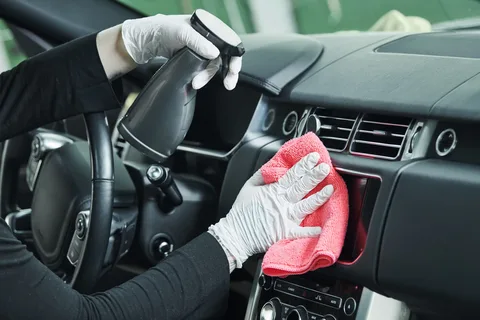A car’s alternator is a critical component that charges the battery and powers the electrical system while the engine is running. It converts mechanical energy from the engine into electrical energy, maintaining a steady supply of power to the vehicle’s systems. Understanding how your alternator works is the first step in troubleshooting an alternator. When it functions correctly, it ensures all electronic components, like lights and radio, operate flawlessly, contributing significantly to your car’s overall performance and reliability.
Regular maintenance of your car’s alternator is vital for its longevity and efficient performance. Keeping an eye on the alternator’s condition can prevent unexpected breakdowns and costly repairs. Effective maintenance includes periodic checks and prompt fixing of alternator issues when they arise. Neglecting these steps can lead to more significant problems, affecting the vehicle’s electrical system and overall functionality.
Recognizing Symptoms of Alternator Issues
Sometimes, alternator problems can be mistaken for other vehicle issues. For instance, a failing alternator can cause similar symptoms to a malfunctioning starter motor. Learning to distinguish these can save time and resources and direct you toward the correct alternator change or repair process. One of the first signs of a failing alternator is an electrical malfunction. This could manifest as dimming headlights, flickering dashboard lights, or sluggish electronic accessories. These symptoms occur when the alternator fails to supply sufficient power. Recognizing these signs early on can be key in preventing further alternator problems and solutions can be more effectively applied.
It’s often confusing to differentiate between a dead battery and an alternator issue. While a dead battery typically results in the car not starting at all, a failing alternator may allow the car to start but struggle to keep it running. Understanding this difference is crucial in how to repair alternator problems effectively, rather than misdiagnosing them as battery issues.
Unusual noises coming from the car’s engine area can be a telltale sign of alternator trouble. A failing alternator may produce a grinding or whining noise due to bearing wear or internal component failure. Listening to these sounds can be a simple yet effective method for early detection of alternator issues.
Step-by-Step Alternator Troubleshooting Guide
The first step in troubleshooting your alternator is a thorough visual inspection. Look for obvious signs of wear and tear, such as loose or corroded electrical connections, cracks in the alternator casing, or visible wear on the serpentine belt. These can be indicative of deeper issues. Ensuring that all connections are secure and in good condition is a fundamental part of maintaining your alternator’s health.
The serpentine belt’s tension is crucial for the proper functioning of the alternator. A belt that is too loose may slip, reducing the alternator’s efficiency, while one that’s too tight can strain the alternator’s bearings and reduce its lifespan. Use a belt tension tool to check the tension and adjust as necessary, following your vehicle’s specifications.
A multimeter can be used to assess the alternator’s output. With the engine off, a healthy battery should read around 12.6 volts. Start the engine and measure again; a well-functioning alternator should show a reading between 13.8 to 14.2 volts. Deviations from these values could indicate alternator issues.
After conducting these tests, interpret the results to decide your next steps. If the alternator shows signs of malfunctioning, such as low voltage output or visible wear, consider repair or replacement. For complex issues, consulting with a professional alternator mechanic may be the best course of action.
Detailed Instructions for Alternator Repair
Before you begin any repair work, especially when dealing with your car’s electrical system, safety is paramount. Ensure that the vehicle is parked on a flat surface and the ignition is turned off. Disconnect the battery, starting with the negative terminal, to prevent any electrical short circuits. Wearing protective gloves and safety glasses can safeguard against accidental injuries.
The removal of a faulty alternator is a meticulous process that requires attention to detail. Start by locating the alternator in your engine bay, which is usually on the front of the engine and driven by a serpentine belt. Loosen the tensioner pulley to remove the belt from the alternator. Label and disconnect all electrical connections from the alternator. Using the appropriate tools, carefully unbolt the alternator from its mounting bracket.
Replacing an alternator can be a challenging but rewarding DIY project. Before you start, ensure you have the following tools on hand:
- Wrench Set: For loosening and tightening bolts.
- Socket Set: Useful for removing hard-to-reach bolts on the alternator.
- Screwdrivers: Needed for removing and securing electrical connections.
- Torque Wrench: Ensures bolts are tightened to the correct specification.
- Pulley Removal Tool: If the alternator has a pulley that needs transferring.
- New Alternator: Ensure it’s the correct model for your vehicle.
- Work Gloves: To protect your hands during the process.
- Safety Glasses: To protect your eyes from debris.
- Multimeter: For testing the alternator’s output before and after replacement.
When replacing an alternator, first disconnect the battery to prevent electrical shocks. Remove the serpentine belt by loosening the tensioner, and then carefully disconnect the electrical connections from the alternator. Unbolt the alternator from its bracket and gently remove it. Install the new alternator, ensuring all bolts are tightened correctly and electrical connections are secure. Finally, reattach the serpentine belt and use a multimeter to confirm the new alternator is functioning correctly.
By following these steps carefully and methodically, you can successfully undertake the task of how to repair alternator issues. However, if you encounter complications or feel unsure at any point, do not hesitate to contact a professional alternator mechanic for assistance. This ensures your vehicle’s safety and reliability, and can often be a more time-efficient choice.
Seeking Professional Help for Alternator Repair
There are situations when it’s advisable to seek the help of a professional alternator mechanic. If you’re not comfortable with the complexity of the repair, lack the necessary tools, or the alternator is in a particularly difficult-to-reach spot, professional assistance can be invaluable. Additionally, if after attempting a repair, you still experience electrical issues or the new alternator doesn’t function as expected, it’s time to consult a professional. A skilled mechanic will conduct a comprehensive evaluation of the alternator and related systems. They have specialized diagnostic tools to accurately pinpoint issues, ensuring that the correct problem is addressed. Expect them to provide a detailed explanation of the issue, a clear estimate of the repair costs, and an overview of the repair process. Professional mechanics should also offer a warranty for their work, giving you peace of mind.
Effective communication with your mechanic is key. Clearly describe any symptoms your car exhibited, and share any attempts you made at diagnosing or repairing the alternator. This information can help the technician accurately assess and address the problem. Don’t hesitate to ask questions about the repair process, the parts being used, and any warranties provided.
Regular maintenance and timely repairs are crucial for ensuring your alternator’s longevity and your car’s reliability. Key strategies include conducting routine inspections, being vigilant about symptoms of alternator failure, and using proper tools and techniques for any repairs.
Understanding when to seek professional help is also an essential aspect of alternator care.
Whether you choose the DIY route or professional services for your alternator problems and solutions, what’s important is gaining confidence in managing this vital component of your car. For those inclined towards DIY, enhancing your mechanical skills and knowledge can be deeply rewarding. For others, building a relationship with a trustworthy mechanic can ensure your vehicle is always in top condition. Ultimately, the goal is to ensure your car runs smoothly, safely, and efficiently.





